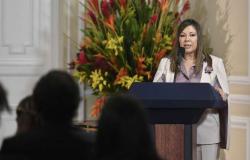Nine years after the brutal femicide of Chiara Páez, a group of people marched through the streets of Salta to demand justice and denounce persistent gender violence. The “Not One Less” movement, which put a stop to violence against women in Argentina, brought together different organizations in the Plaza 9 de Julio, from where a march began that toured the center of the city.
The central event in the city of Salta began in the emblematic Plaza 9 de Julio, where various feminist, sexual diversity, social, political, and union organizations gathered to begin the march. From there, the protesters marched to the provincial Legislature and then to the Police Headquarters.
During the march, the different representatives of social organizations had their turn at an open microphone, which allowed them to make the demands and measures that are missing to make the fight against gender violence truly effective. One of them was Irene Cari, president of the Women’s Forum for Equal Opportunities, who took her turn at the microphone, in the protest in front of the provincial Legislature, where she demanded concrete actions by the national State, for needy families and the support provided to school cafeterias. “Today many kids don’t go to school because they don’t have sneakers. Much less to eat,” said Cari.
The next stop of the march was at the Police Headquarters headquarters, where a court case that occurred in the city of Metán was presented. It was the testimony of Joel, a young teacher who requested her job transfer from the city of her origin to Salta, due to gender violence, carried out by her ex-partner. At this time, Joel lost custody of her son in November, and is currently demanding action from the Metán Justice Department.
The return to the Plaza 9 de Julio
The end of the march was after 7:30 p.m. when the column of protesters headed again towards the Plaza 9 de Julio, but to express themselves in a new repudiation in front of the Cathedral. On Belgrano Avenue, a column from the Partido Obrero withdrew from the protest for Mitre, while the remaining group continued on its way to Zuviría where it went down the wrong way towards the Cathedral.
During the Ni una Menos march, they remembered the three women murdered in Barracas. PHOTO: Pablo Yapura
During the Ni una Menos march, they remembered the three women murdered in Barracas. PHOTO: Pablo Yapura
During the Ni una Menos march, they remembered the three women murdered in Barracas. PHOTO: Pablo Yapura
In the Cathedral, the protesters remembered the three lesbian girls murdered in Barracas, Buenos Aires. They placed their images on the fence that had been placed in the early hours of the day in front of the Cathedral and later candles were lit in their memory.
Almost at the end of this new Ni una Menos march, the protesters reiterated their request to both the national and provincial governments to take care of the safety of lesbian women, who were victims of violent attacks in recent months and about what the Justice has not yet resolved or condemned.
The organizers highlighted the importance of this mobilization: “Nine years after the first Ni Una Menos, this demonstration continues to call us, because many of the demands of 2015 remain unfulfilled.” The banners and chants reflected strong messages such as “Not one less, we love each other alive” and “Lesbians march too.”
One of the testimonies of the day was that of an activist who expressed: “One more year finds us with a very great mourning in the face of the lesbicide of three companions in Barracas. This lesbicide puts us on the streets to raise awareness about what violence means and that you can say no to any type of violence. There are bodies of women, trans and lesbians that appear in public; we need the serious commitment of the government, institutions and society to eradicate violence and discrimination.”
New march for Ni una Menos. Photo: Pablo Yapura
The lack of budget and resources to combat violence against women was another of the highlights of the march. “Little is done for those who make complaints; there is little response in supporting women in the face of the aggressor’s threat. There are poor women who are victims of violence and need a serious commitment and financial compensation to be able to continue with their lives,” said a representative of a feminist organization.
New march for Ni una Menos. Photo: Pablo Yapura
She added: “Once again, women are in the streets shouting to stop femicides and structural and institutional violence. Women who seek restorative justice find themselves re-victimized by judges.”
The march in Salta, like in other parts of the country, shows that the cry “Ni una Menos” continues to resonate strongly, underlining that the fight for justice and against gender violence is still necessary and urgent.
New march for Ni una Menos. Photo: Pablo Yapura
New march for Ni una Menos. Photo: Pablo Yapura
New march for Ni una Menos. Photo: Pablo Yapura






